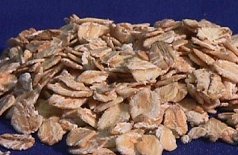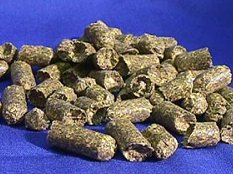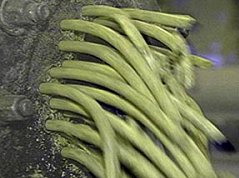Previous Page | Right click this page to print.
Grain Processing
We'll talk a little about grain processing. Grain processing can be divided into two different types, that called cold processing and that where heat is used to help process the grain. First of all, in cold processing, we have a number of cold processes we can use. One of those is rolling the grain. Now, rolling is essentially crushing grain products through crimped rollers, grains drops through the top, two closely set rollers are rotating counter to each other and simply crush the grain and drop it out the bottom. This is a fast, fairly economical way of processing grains that are similar in size and texture. For example, you can process various corn through a roller mill, but it is more difficult to process corn mixed with barley or oats through a rolling mill because the size of the kernels are different and you'll crack the corn more than you'll crack the barley or oats. Grinding is a second way of cold processing grain, this is simply a process where grain is fed into a container with swinging hammers, small knives that are swinging at a high rate of speed and break the grain into a number of pieces. This is a bit slower than dry rolling grain and requires a bit more energy, but the one advantage is that you can process different grains at the same time, in other words, the mix of corn and barley would go through a grinding mill very well.

Another method of cold processing grain is called soaking or reconstitution. This is where we simply soak grain in water, this swells the seed coat and makes the inside of the grain, where starch and other nutrients are located, more available to the animal. Soaking and reconstitution is really not suited to processing large quantities of grain and once the grain is processed through soaking it must be fed quickly because it will spoil rather quickly and when water is added to grain it also limits your ability to transport this grain to distant feeding areas because you are carrying less dry matter and more water. The advantages of soaking are that if you sprout legumes with a presoaking processing you'll reduce the antinutritional factor, trypsin, in these grains. And so it can be low cost way of processing for a special purpose on a small scale.
Another method of cold processing is called acid preservation. This is essentially where we'll ensile or pack grains into an air tight storage and allow fermentation to take place or bacteria produce organic acids that then preserve the grain indefinitely as long as it's held in an air tight structure. Grains can also be treated with organic acids directly and then stored in an air tight structure to preserve them. Acid preservation makes nutrients in the grains slightly more available and makes the grain more palatable. It reduces the need to dry the grains prior to storage, so you can harvest high-moisture corn in the field, store it in a special structure and not have to go through the expense and the process of drying the grain prior to storage. Palatability of acid preserved or ensiled high-moisture grains is good, but generally, there will be a slightly reduced intake, especially when fed in diets with high-moisture forages included. When feeding high moisture corn that has been preserved in a silo or other air tight structure, we generally will feed this pound for pound with a whole corn on a dry basis. The Table in your text, 11-10, shows the results of some trials where high moisture corn was fed in place of dry corn and the results they achieved there.
The other part of processing is heat processing. This is where heat is provided in some way in aiding the processing of grain. One of the most common methods of heat processing grain is called steam rolling or steam flaking. This is where grain such as barley, corn, oats are poured into a large chamber and then hot moisture or steam is introduced and the grain is held for a period of time to absorb some of this hot moisture. After this then the grain is rolled as before in the cold process with the rollers, counter-rotating rollers. Flaking is just a different version of steam rolling where the grain is held in the steam for a longer time and achieves a higher moisture content in the grain and by doing so you can create a flatter rolled flake the starch is gelatinized as well which makes it more available to the animal.

A second way of heat processing grain is called pelleting. Pelleting is essentially where a feed is ground and then pushed through holes in the side of a drum to make round pellets. The pressure, of course, creates heat as the pellet is expressed through the hole and this creates also some gelatinization of the starch. Pellets generally are denser than ground or flaked grain and multiple ingredients can be incorporated into the pellet. In other words the ground grain can be mixed with other feed commodities and then expressed out the pellet die and you will have a pellet that contains multiple ingredients. Pelleting can also be used to make fines, the powder from grain processing, more palatable to livestock. Generally, fines are unacceptable and will be sorted out by livestock and not eaten. But when forced through a pellet machine and made into pellets, cattle will more readily eat them.

A third way of heat process is called extrusion. This is very much like a pellet mill where a feed is introduced into a chamber and then under pressure it is pushed out of holes or dies to create a product. In extrusion, generally, the product we push through the die contains more moisture and it may have a very high level of fat as well. Extruded products can be dried and then crumbled so that they can be handled and stored much like an ordinary grain. The heat in this process can do two things. One it destroys the anti-growth factors in legumes as we have talked about before. But it also can be used to protect some of the protein in products like soybeans from breakdown in the rumen, thus creating a by-pass or extra protein that can be digested by the animal lower in the digestive tract.

Finally, in heat processing, you may hear about popping or exploding or micronizing grain. These are all ways where we simply heat the grain up in a vessel and allow the moisture inside to turn to steam and physically explode the grain inside-out, just like popping corn. It reduces the density of the feed significantly. If you hold in your hand a cup of popcorn unpopped and then the equivalent amount as popped, you'll notice the density will be much less. You will have much bigger pile of popped corn than unpopped corn. Popping or exploding grain is not very popular, we don't see it very often. It is not suited for processing large quantities of grain and it is uncommon to see it used in commercial practice today very much.
Finally before we leave grain processing just a word or two about spray-coating of processed grains. After grains have been processed and perhaps mixed, fat, molasses or other liquid feed ingredients can be sprayed on these feeds or when they are loaded onto a truck or into a feeding bin or at the feeding area in the barn. These coating can include things like yeast, mineral-vitamin sources, and other feed additives. And in general they'll increase palatability, they reduce the dustiness of processed grains and also reduce the amount of fines or powder that are generated as animals consume the mixed feeds.
Previous Page | Right click this page to print.